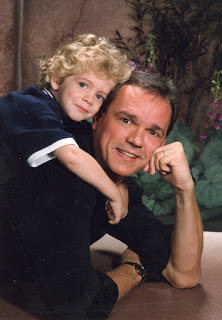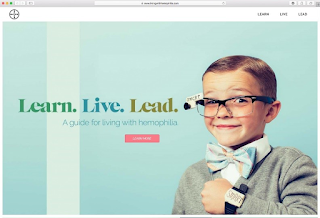I was scanning through Facebook, wondering what to write about for Sunday night, and came across a post by one of my hemo-heroes,
Luis Andres Aguayo. I’ve never met “L.A.”, though he wrote an article for PEN last year and we’ve chatted on the phone. He is a body-builder, and posts regularly about his competitions and more importantly about his training.
Despite the fact that I’m old enough to be his mother, his posts inspire me; his life inspires me. His physique is incredible. He has absolutely sculpted it through determination, goal-setting, pain, and infinite number of hours in the gym. All the while, he remains humble and a joy to speak with.
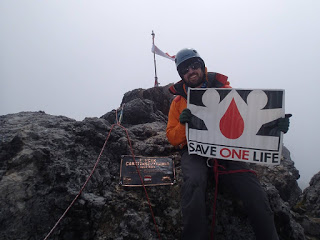 |
Chris Bombardier on Carstenz Pyramid, one of
the Seven Summits |
I’m training too, for a mountain trek to Everest base camp in April with another hemo-hero, Chris Bombardier from Colorado. Chris also has goals, determination and infinite hours spent hiking and climbing to prepare. And… I am also old enough to be his mother!
Training is hard at age 59, even when you think you’re in pretty good shape. These two heroes have hemophilia, and when I think of what they are accomplishing in spite of their disorders, I get motivated to push harder. Chris has already summited five of the Seven Summits! L.A. came close to winning being on the cover of a men’s fitness magazine! I love mountain climbing, and I love weight training, so it’s natural I enjoy following these guys as they train.
But it’s tough for me. Even just five years ago I saw tremendous change when I worked out consistently. Now, it’s like everything takes twice as much for half the results. But I keep going!
Tonight I am aching all over from a double whammy: training at 8 am for an hour with my trainer Dan French, and later in the day running 6 miles in the 45° weather. My treadmill died last week (no, not from overusing it) and nothing beats running outside. I felt good but ouch, later on, aching knees and back.
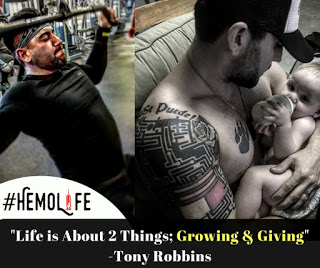 |
| One of my hemo-heroes! |
I have 6 weeks left before the Everest trek. Here’s what a typical week is like while training:
Sunday: Day off. Recovery is very important for the body, especially at this age. I’m paranoid about getting an injury which is all too easy to do.
Monday: Yoga for 30 minutes (a MUST!). Training with Dan, upper body and abs, one hour.
Tuesday: Yoga. Cardio… either in the gym in Salisbury, Massachusetts, or at my home gym. I can ride my stationery bike while watching a documentary about mountain climbing, or throw on a 20-lb backpack and hike up and down for 90 ridiculous minutes on a plyo box over and over while watching Dr. Strange or Mad Max. Superhero movies make you feel empowered! This is a killer workout.
Wednesday: Training with Dan, lower body (tons of lunges and jump squats) and abs.
Thursday: Yoga. Cardio, maybe the elliptical for 90 minutes at the gym, excellent workout!
Friday: Yoga. Training with Dan, speed work-out. This is a killer too. Usually Dan and I chat about music, but 10 minutes into this workout I can’t talk. I even get dizzy.
Saturday: More cardio!
And food: 75% of training is eating the right food and having the right diet. Dan analyzed my diet 6 years ago when he was getting me ready for Kilimanjaro and saw I needed more water and protein, and basically overhauled how I ate. So I cut out (for the most part): soda, diet soda, fruit juice, alcohol, sugar. We don’t keep any of that in the house. No pasta, white bread, desserts. A typical day goes just like this:
Breakfast: three scrambled egg whites, cantaloupe or banana, black tea.
Lunch: (and after a workout) A protein shake with banana, pineapple (or berries), 14 raw almonds and GNC Whey protein powder. Delish.
Dinner: I don’t actually eat dinner unless I go out. Why? I don’t know how to cook and don’t even like to cook. Things burn and catch fire all the time. So I have another shake, or a salad with protein (shrimp, eggs), or a banana with organic peanut butter. I eat out about twice a week, when I’ll have fish.
My demons? Movie popcorn and M&Ms. I love going to movies and twice I have not had movie popcorn and it was not the same experience! And Dan tells me movie popcorn is the worst thing you can eat, next to Cinnabon.
Despite having a trainer, I still get motivation from people like L.A. and Chris. As they give hope to young guys with hemophilia to reach their dreams, I hope I can inspire some moms who want to get in shape. It’s never too late to start. It helps to have a goal, a big goal, like a mountain climb. Kilimanjaro was an incredible experience, both times! And I know Everest base camp will be a dream come true.
L.A. wrote this recently on Facebook: “Keep this in my notes! What’s your one sentence destiny? The vision you base your decisions on?” His is, “Use adversity to change others’ lives.” And Jordan Romero, the youngest person to conquer the Seven Summits, asks, “What’s Your Everest?”
I love that. Our Everest climb will put a spotlight we hope on Nepal and its people with hemophilia, who live in hardship, especially after the 2015 earthquake. We’re going to meet with the 80 people we help through
Save One Life. You can follow
L.A. and
Chris on Facebook, and read HemaBlog to see how the training and eventually the climb are going!
Great Book I Just Read
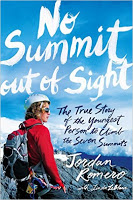 No Summit Out of Sight: The True Story of the Youngest Person to Climb the Seven Summits
No Summit Out of Sight: The True Story of the Youngest Person to Climb the Seven Summits
Jordan Romero
An inspirational book about the boy who summited Everest at age 13, and conquered all Seven Summits by age 15. Despite warnings from critics about having someone so young attempt something so dangerous, Jordan was well prepared, genetically-gifted and just plain lucky. He documents what inspired him, his training, his observations of the countries, people and climbs. It’s fun and interesting, and Jordan’s a marvel. He uses his climbs to motivate other children now by posing the question: What’s your Everest? A light read, but very engaging. Kudos to this remarkable young man and his family! 3/5 stars.

